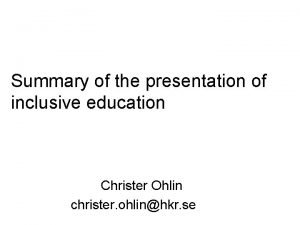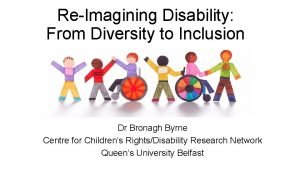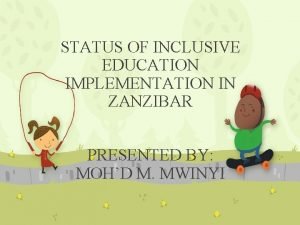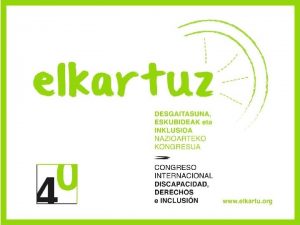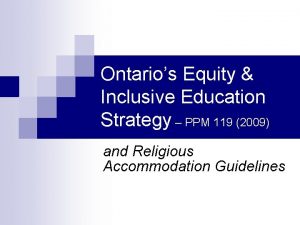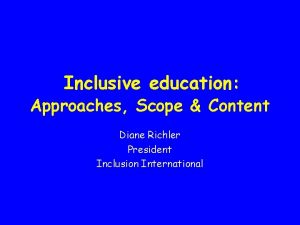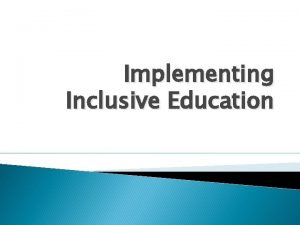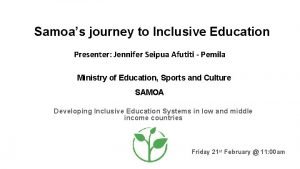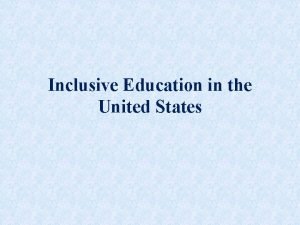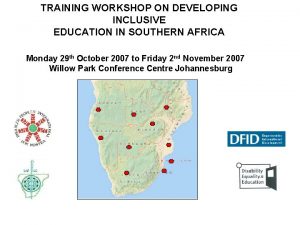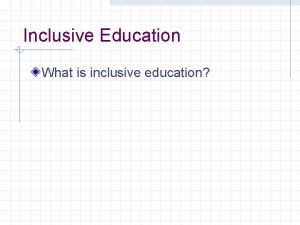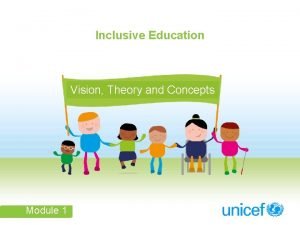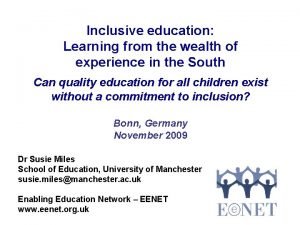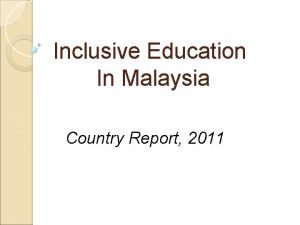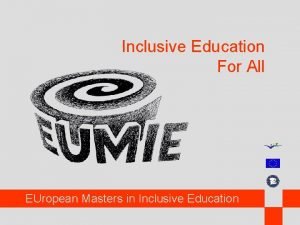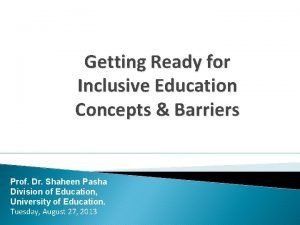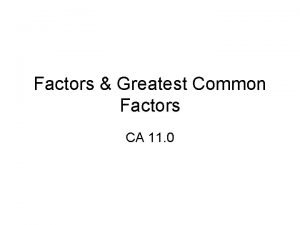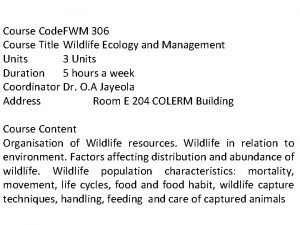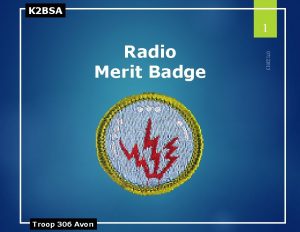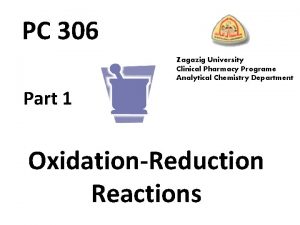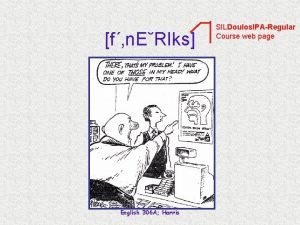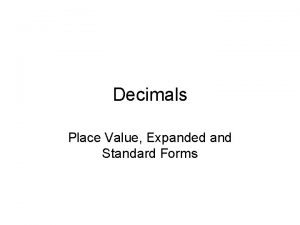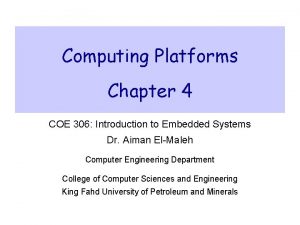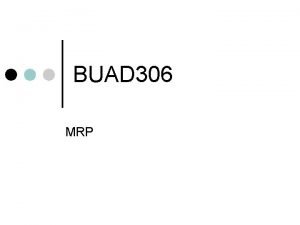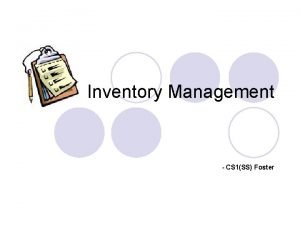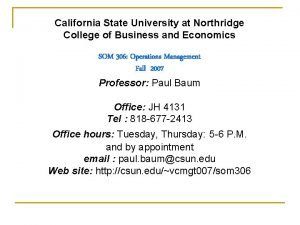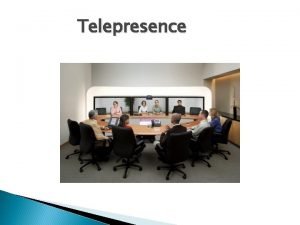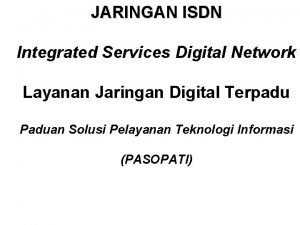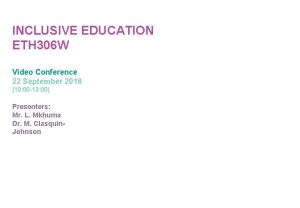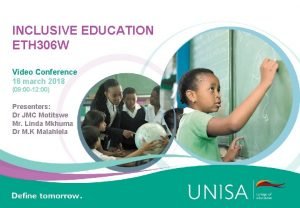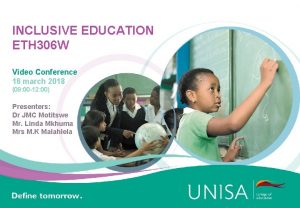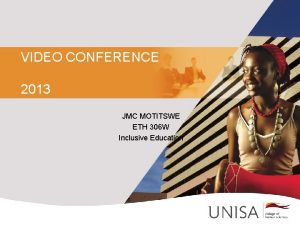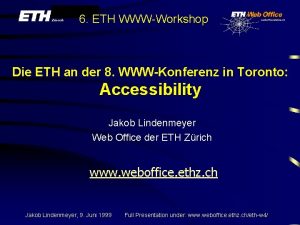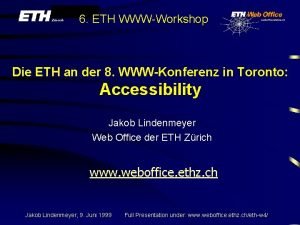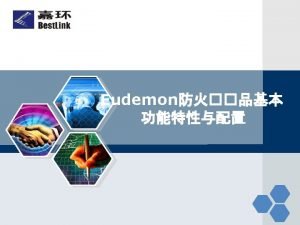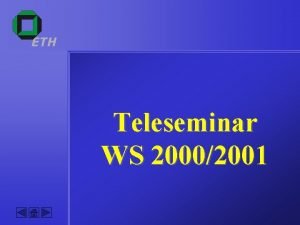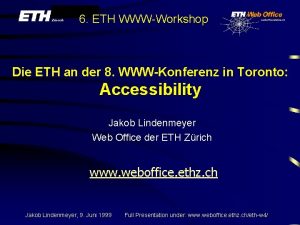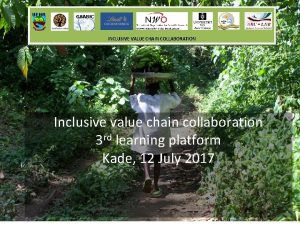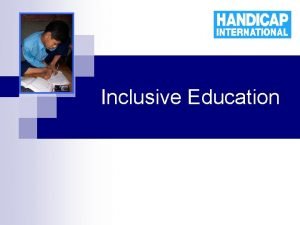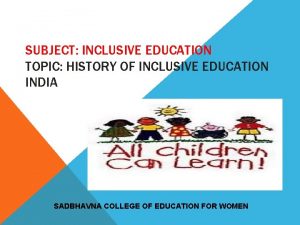INCLUSIVE EDUCATION ETH 306 W Video Conference 29











































- Slides: 43

INCLUSIVE EDUCATION ETH 306 W Video Conference 29 April 2016 (9: 00 -11: 00) Presenters: Mr. L. Mkhuma Dr. M. Clasquin. Johnson

Feedback on Assignment 2 Preparing for Assessment – Assignments and Examination - Read analyse the questions very carefully. Follow the mark allocation. Number your answers correctly. Do not deviate from the instructions: discuss, describe, name, explain or provide examples, compare/contrast/tabulate, motivate your answer/provide a reason for your opinion - Please note: Some questions are compulsory. Some questions are for specific phases of specialisation.

Common Errors in Assignment 2 • No reference to your study guide. READ your study guide. • General answers that failed to address the specific questions. • Including irrelevant information – in the examination you would be wasting time. - For example: We asked “What is inclusion”? We did not ask what the advantages are, or what the short-term and longterm goals of inclusion are. You were required to provide a DEFINITION of inclusion. • Make sure that you understand exactly what the question requires. Therefore, analyse the questions carefully. • Do not leave any section blank. Attempt every question.

Question 1 - The principal of the school where you are teaching asks you to tell the other staff members what Inclusive Education and intrinsic and extrinsic barriers to learning and development are. - Write your speech, making use of headings and subheadings. The speech should be two to three pages if typed or three to four pages if handwritten. Refer to Study Unit 2 (p. 18) and Appendix N (p. 319) of your study guide. (30) - Answer all three subsections of the question, in a balanced way. Ideally, strive to provide 10 facts (10 marks) per section.

What is Inclusion? Definition of inclusion: Inclusion is about increasing the participation√ of learners in and reducing their exclusion from the cultures, curricula, and communities of local schools. It involves restructuring the cultures, policies and practices√ in schools so that they respond to the diversity√ of learners. It is concerned with the learning and participation of all learners√ vulnerable to exclusionary pressures, not only those with impairments√ or those categorised as experiencing barriers to learning and development√.

What is inclusion (continued) It is concerned with improving schools√ for staff as well as learners. Acknowledging that all learners have a right to education√ in their local community. Diversity√ is not viewed as a problem to overcome, but as a rich resource√ to support the learning of all. Inclusion is concerned with fostering mutually sustaining relationships between schools and communities√. Inclusion in education is one aspect of inclusion in society√.

What is Inclusion? Overview of White Paper 6: Special Needs Education: Building an Inclusive Education and Training System Ten reasons for inclusion • • • A human right Good educational sense Good social sense The right to learn and live together Accept diversity Respect for one another Uniform and responsive education system Remove discrimination Positive interaction and learning from one another Rehabilitative and supportive society

What is Inclusion? • Increasing participation of all learners, not only those with impairments • Reducing exclusion from cultures, curricula and communities of schools • Responding to learner diversity • Improving schools for teachers and learners • Overcoming barriers to access and participation • Regarding education as a right • Regarding diversity as a rich resource • Fostering mutually sustaining relationships • Acknowledging that all learners need support • Meeting all learners’ needs

External Barriers to Learning At home, at school and in the community (differentiate) External to the learner - Socio-economic barriers - Discriminating attitudes - Inflexible curriculum - Language and communication - Inaccessible and unsafe environment - Inapplicable or inadequate provision of support services - A lack of empowering and protective policy - Disability - A lack of human resources development Discuss each in detail. Refer to your study guide pages 19 -20.

Internal Barriers to Learning - - Factors inherent in learners themselves. Learners were born with these or acquired them later on. Factors not related to education or environment. Include physical, physiological or mental impairments. Note: degrees of impairments Have a detrimental effect on learner’s progress at school if learner does not receive appropriate support. Note causes: genetic factors, prenatal/perinatal/postnatal brain damage (epilepsy, cerebral palsy, learning impairments such as dyslexia (difficulty with reading) or dyscalculia (difficulty with arithmetic), intellectual impairment, hearing impairment, visual impairment) These learners require more specialised educational methods and teaching aids.

Question 2 You are a teacher in the Foundation Phase or Intermediate Phase or Senior and FET Phase. You notice that there are two learners in your classroom with hearing and visual impairments. 2. 1 Name FIVE characteristics of each of these types of impairment as they manifest in the classroom. (5 x 2 = 10) 2. 2 Discuss how you as a teacher would support these learners in the classroom in terms of each learner’s specific type of barrier to learning. (5 x 2 = 10) 2. 3 As a teacher, what assistance could you give a learner with a physical impairment in your classroom? (10) Common errors: The charity approach is not inclusive education! Be specific (not vague and general).

Hearing Impairments: Characteristics (Question 2. 1) - Often misinterprets instructions - Turns head to listen - Watched the teacher’s lips - Cannot understand the teacher if the teacher’s head is turned away or the teacher’s lips are covered - Finds it difficult to locate the source of a sound - Speaks too loudly or too softly - Speaks monotonously - Speaks too quickly or too slowly - Experiences unusual emotional problems - Is often inattentive

Hearing Impairments (Characteristics continued) - Stares out of the window if the teacher stands at the back of the class while giving instructions - May have difficulty hearing the bell ring - Finds it difficult to associate with friends - Cannot follow instructions given in a large hall such as a school assembly hall - Cannot follow what is being said in a noisy or rowdy group - Experiences problems with auditory memory - Finds it difficult to retell a story - Finds it difficult to discriminate aurally between pairs of words starting and ending with different sounds

Visual impairments Characteristics - Loss of or restricted vision influences the language, motor and socioemotional development of the learner Itching, burning or scratchy feeling in the eyes Inability to see well Dizziness, headaches, or nausea, following close work Blurred or double vision Inability to see in bright light

n errors: Do not discuss cataracts, etc. ! Barriers type of eye condition will determine the assistanc rners with myopia and cataracts should sit in-front, eat (verbally) what is written on the chalkboard. a magnifying glass if large print books are not ava a koki pen to draw parallel lines on paper. ted material should be clear, attractive and meanin al Classroom Support Strategies: (Question 2.

n errors: Do not discuss cataracts, etc. ! arriers type of eye condition will determine the assistanc ners with myopia and cataracts should sit in-front, eat (verbally) what is written on the chalkboard. a magnifying glass if large print books are not ava a koki pen to draw parallel lines on paper. ted material should be clear, attractive and meani al Classroom Support Strategies: (Question 2.

ies g e t a r t S t r ppo u S m o o r s las Practical C iers r r a B y r o t i Aud al. i r e t a m t n e res p o t r o t c e j o er. r p p a d p a n e o h r b r e a v o e ing c h s t u n i s e g t n o i - Use an n w o e tak s foll o i t r r e e n e r p a e a l n e. t h t n t e a m h t n g k i - Assig c s e s na o ch a s l n a o n g a n i c k r r e o e c s is w a s p a l c e - The pe t e a r h t e d n mo whe a t e c a a l d p n t a c e e r c voi cor l a m r o n a n learly i c k a e p S ion. t n e t t a s ’ r e learn e h ally t (speed). r o n i f a o g g o n t i d s l n rsta signa e l d a n u u s ’ i s v r e e s n lear - U k c e h c o t s stion e u q s. n k o s i t A c e r i d r ore nt o m e t t i n o e c k a d e m t n o ns t o i prese t s e u q r o ntent o c e s a r h p - Re le. b a d n a t s r e und

Practical Classroom Support Strategies: Auditory Barriers - Supplement information presented orally, with visual aids. - Give test directions, assignments and lecture outlines in writing. - Cue the learner visually to indicate that someone is talking over the intercom. - Make sure that someone explains the message over the intercom to the learners with auditory impairments. - Provide learner with outlines, assignments, vocabulary lists before introducing new material. - Remember to present all spelling and vocabulary words in sentences. - Try to limit movement and unnecessary gestures when speaking to students with hearing impairments.

Practical Classroom Support Strategies Physical Barriers (Question 2. 3) - Ensure learners are comfortable with orthopaedic aids. Take time to explain these to the rest of the class. - Try to make the classroom easily accessible. - Build the learner’s self-esteem – as persons of worth who have potential. - Improvise – what would you do if a wheelchair had a flat wheel? - If the learner has difficult writing, try to obtain a typewriter or computer and spend time teaching him/her to write. - Allow learners to take tests and examinations orally. - Try to restrict incidents that cause distractions. - Provide washing facilities for learners who wheel themselves into the classroom (to wash their hands).

Question 3 What will you do if a learner has an epileptic seizure in your class? (10) - Be alert! Look out for warning signs. Record all incidents of seizures. Remain calm. Prevent the learner from falling. Push furniture out of the way. DO NOT HOLD THE LEARNER OR TRY TO PREVENT MOVEMENT! Ensure that the airway is clear. Turn the learner onto his/her side to prevent choking on excessive saliva. Loosen tight clothing, especially around neck and waist. Seek medical assistance if seizure is protracted, or if learner chokes, or if learner sustains any injuries.

Question 3 What will you do if a learner has an epileptic seizure in your class? (10) Medical assistance should be summoned if: Severe seizures are protracted or recur at frequent intervals The child chokes – seek immediate assistance, and ensure that the air passages are clear If injuries that occur during a seizure require medical attention Inform parents as soon as possible of any seizure Treat learners with sympathy, but be firm Strengthen their feelings of security, if they receive special assistance to join activities of groups, and if they feel accepted Support learners to become useful members of society.

Question 4 Do either question 4. 1 or 4. 2 depending on the phase for which you are enrolled. Question 4. 1 ECD phase 4. 1. 1 A learner in you class has behaviour problems. Explain the different behaviour problems that may occur and explain what assistance you can give to this learner. (20) 4. 1. 2 Name and discuss the types of motor skill problem that a learner with Down’s syndrome might have. (10) OR Question 4. 2 Intermediate and FET phases Describe five unmet emotional needs of learners in the Intermediate or FET phase and explain what you as the teacher can do to support learners with these unmet emotional needs. (5 x 6= 30)

Question 4. 1. 1: Behavioural Problems as a Barrier - - Antisocial behaviour Taking others’ property Aggression Bossiness Egocentricity Destructiveness Antagonism towards members of the opposite sex Social aggression Negatively influence learner’s development and learning Explain each of the above.

Behaviour modification techniques: - Reinforcement - Ignoring Time-out / Withdrawal (special circumstances, with circumspection and warn the learner beforehand) Self-chosen time-out / withdrawal Prevention Redirection Discussion / conversation (and find a workable solution) Special time (spend time alone with the learner) Revise pages 230 -255

Question 4. 1. 2. Types of Motor skills problems that a learner with Down syndrome might have Poor manipulation due to: (i) Hypotonia (low muscle tone) in arms and hands (ii) Shorter limbs and digits (iii) Reduced stamina Implications: • Handwriting may be oversized or undersized and light/sketchy • Manual skills such as cutting, using concrete materials and equipment may be less accurate and completed more slowly.

Support Strategies (motor skill problems experienced by learners with Down Syndrome): Use alternative tasks for recording e. g. cut and paste, multiple choice, etc. Use large/adapted equipment (ruler with ridge for gripping, blackboard compass) Reduce the amount of activities/ work expected. Provide proformas in a large size with some information already recorded.

Question 4. 2 Five unmet emotional needs: Identify ANY five from the list below The need for love and affection - relationships (bond) with mother and father - attachment - basis for all other relationships The need for security (including the need for economic security) - feelings of security - stable relationships - know what is expected - self-image - Identify: Who am I?

Question 4. 2 Five unmet emotional needs: The need to belong - Belong to family, peer group - Feel they belong in the classroom - Interact / participate in group situations The need for new experiences - For mental growth - Stimulate thinking and development - Prevent boredom - Challenging and diverse tasks - Relevant, interesting, meaningful learning experiences

Question 4. 2 Five unmet emotional needs: The need to be free from the intense feelings of guilt - Guilt as result of unrealistic expectations of parents and teachers - Guilt leads to feelings of inadequacy and not belonging The need to be free from feelings of fear - Learners learn best when relaxed, calm and environment is stable - Allow learner to share feelings, fears, anxieties - Protect learners’ emotional well-being

Question 4. 2 Five unmet emotional needs: The need for praise and recognition - Learners will develop a positive self-concept - Feel accepted - Recognise their efforts and achievements - Feel encouraged - Enhances learners’ effectiveness of learning - Sense of efficacy - Feel valued The need for self-actualisation - Feelings of accomplishment (success) – basis to seek new challenges - Realise full potential - Avoid/prevent destructive behaviours (drugs, alcohol, etc. )

Question 4. 2 Five unmet emotional needs: The need for a positive self-concept and an understanding of the life-world - Learners must feel good about themselves - Feel that they know and can do things – experience success - Self-confidence - Feelings of security – take risks to ask questions, make mistakes in safe space of the classroom The need for sharing and self-respect - Pressure to conform to adults’ expectations - Need for ground rules, discipline - Low self-respect leads to negative behaviour and poor sense of self-worth

Question 4. 2 Five unmet emotional needs: The need for responsibility - Classroom responsibilities, and chores at home (reasonable) - Need positive adult role models - Make responsible choices and decisions - Take responsibility for consequences

Down syndrome is the result of an oddity of genes in the twenty -first chromosome. Children with this syndrome usually have a slow rate of learning. Motor skills’ challenges are common. Poor manipulation due to: - Hypotonia (low muscle tone) in arms and hands - Shorter limbs and digits - Reduced stamina Implications of motor skills’ challenges are that: - Handwriting may be oversized or undersized and light/sketchy - Manual skills such as cutting, using concrete materials and equipment may be less accurate and completed more slowly.

Visual Perception: - Difficulty ordering a sequence - Reversal of images - Random visual scanning Implications of visual perception difficulties are: - Difficulty in perceiving and predicting a pattern/sequence - Unable to reliably read a number e. g. 43 becomes 34, 6 for 8 etc - Will miss information when presented in a cluttered or random manner. Cognitive characteristics include: - Learners exhibit a wide range of abilities - Comprehension/interpretation of verbal and written instructions appear to be more advanced than actual ability/level. - Abstract thinking is limited - Learners are unable to transfer knowledge to a new situation - Learners are unable to separate pieces of information and form links

Implications of cognitive characteristics are: - Asynchrony across subject areas i. e. may be more skilled in reading than in mathematics. A learner with Down syndrome varies in her/his abilities and skills compared to her/his peers. Comparisons are difficult - Working pace is usually slow due in part to intellectual disability and poor motor skills. - Appears to understand/confirm he/she understands but fails to comprehend the activity. - The learner will misinterpret words with more than one meaning e. g. light can relate weight or illumination - Unable to interpret and complete tasks Memory - Short term (working) memory is poor. - Long-term recall is poor. - Difficulty recalling and following the sequence e. g. using a calculator.

Implications of limited memory are that learners may: - Be unable to store information long enough to process and respond to it. - Use incorrect responses to previously known skills. - Experience difficulty getting stared as they are unsure of the sequence. Attending skills - Learner’s work is incomplete - Adult intervention is frequently required to keep the learners on the task - Learners will exhibit a range of problem behaviors. They may not follow the whole class verbal instructions. They tend to complete the last section of the activity. - Learners may pick up an element of the instruction and go off on a tangent in their thinking.

“Autism or Autistic Spectrum Disorder (ASD) is a lifelong, complex, pervasive developmental impairment, which appears to have a genetic predisposition and stems from a multi-faceted origin, causing disturbances in brain development and functioning. ” Typical behaviours may include the following: - Little or no eye contact - Abnormalities in the development of cognitive skills; for example, poor learning skills or resistance to normal teaching methods - Unusual responses to sensory inputs, such as covering the ears - Sense of touch, taste, sight, hearing and/or smell may be heightened or diminished - Bizarre eating patterns - High pain threshold

Crying or laughing for no apparent reason - Self-injurious behavior such as head banging, scratching and biting - Abnormal sleep patterns - The development of speech and language may be abnormal, delayed or absent. - A person shows minimal reaction to verbal input and sometimes acts as though deaf. - The repetition of words, questions, phrases and/or sentences over and over again - Endless monologues about their special interests without adapting to the needs of the listener - Words and phrases may be used incorrectly. - The production of speech may be unusual. A flat monotonous tone or inappropriate variations in tone are often noted. -

- Those who are verbal, may be fascinated with words and word games, but do not use their vocabulary as a tool for social integration and reciprocal communication. They have difficulty in initiating or taking part in conversations. Imaginative play may be limited or poor; for example, they cannot play with a wooden block as if it is a toy car. A tendency to focus on minor or trivial aspects of things in the environment instead of an imaginative understanding of the meaning of the whole scene They may display a limited range of imaginative activities, which a teacher may well find have actually been copied off the television or elsewhere. They pursue activities repetitively and cannot be influenced by suggestions of change. Their play may appear complex, but close observation shows its rigidity and stereotyped pattern.

- - Unusual habits such as rocking, spinning, finger-flicking, continual fiddling with objects, spinning objects, tapping and scratching on objects, or arranging objects in lines or patterns Inappropriate use of toys in play Holding onto objects; for instance, carrying a piece of wool the whole day Noticeable physical over-activity or extreme under-activity Tantrums may occur for no reason. Changes in routine of environment; for example, a change in the route to the school or altering the placement of equipment in the classroom may cause distress.

- - Interests and range of activities may be limited; for example, they are only interested in puzzles. A small percentage of learners have abilities that are outstanding in relation to their overall functioning; for example, exceptional memory in a specific field of interest or exceptional art ability. Despite these definitive feature NO TWO autistic learners are the same. Every learner is unique and will have a unique profile. Current research is promoting the view of autism as human diversity, natural human evolution and giftedness.

How to contact us: Mr. Lindokuhle Mkhuma Tel: 012484 1121 E-mail: mkhumi@unisa. ac. za Address: UNISA Sunnyside Campus, Building no. 10, Office 1 -96, Pretoria 0003 Dr. Mary Clasquin-Johnson Tel: 0124812763 E-mail: clasqmg@unisa. ac. za Address: UNISA Sunnyside Campus, Building no. 10, Office 1 -57, Pretoria 0003

 Conclusion about inclusive education
Conclusion about inclusive education Reimigining disability and inclusive education
Reimigining disability and inclusive education Achievement of inclusive education in zanzibar
Achievement of inclusive education in zanzibar Reimigining disability and inclusive education
Reimigining disability and inclusive education Ontario's equity and inclusive education strategy
Ontario's equity and inclusive education strategy Diane richler
Diane richler Unesco inclusive education
Unesco inclusive education Inclusive education policy
Inclusive education policy What is this photo
What is this photo Inclusive education and community partnership
Inclusive education and community partnership Objectives of inclusive education
Objectives of inclusive education Npe 1986 conclusion
Npe 1986 conclusion Aims and objectives of inclusive education
Aims and objectives of inclusive education Objectives of inclusive education
Objectives of inclusive education Inclusive education definition
Inclusive education definition Disadvantages of inclusive education slideshare
Disadvantages of inclusive education slideshare Inclusive education and community partnership
Inclusive education and community partnership Leader acrostic
Leader acrostic Definition of inclusive education by authors slideshare
Definition of inclusive education by authors slideshare National general benefits solutions providers
National general benefits solutions providers Gcf of 25 and 30
Gcf of 25 and 30 306 subject code
306 subject code Om306
Om306 Troop 306
Troop 306 Ed 306
Ed 306 Virtudes teologales
Virtudes teologales Pc 306
Pc 306 Paulo sentelhas e angelocci geadas aula lce 306
Paulo sentelhas e angelocci geadas aula lce 306 Paulo cesar sentelhas
Paulo cesar sentelhas Paulo sentelhas e angelocci geadas aula lce 306
Paulo sentelhas e angelocci geadas aula lce 306 306
306 306 in expanded form
306 in expanded form 306
306 Buad 306
Buad 306 Buad 306
Buad 306 Human vertebral formula
Human vertebral formula Navsup form 1282
Navsup form 1282 Som 306 csun
Som 306 csun Disadvantages of telepresence
Disadvantages of telepresence Polycom video conferencing equipment
Polycom video conferencing equipment Adobe video conference
Adobe video conference Gvc conference
Gvc conference Koneksi isdn
Koneksi isdn Yandex ru video search text
Yandex ru video search text
